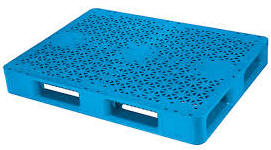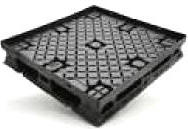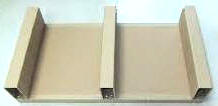|
|
|
|
|
Pallet of |
|
Part 2 |
|
Although timber seems to be the predominant material used in the fabrication of pallets, feasibility studies on the use of different materials have brought to the forefront materials such as metals, plastics, wood products and composite compounds.
1. Metals- steel, aluminum alloys 2. Plastics- injection molded, light weight formed 3. Wood Products - cellular boards, chipboard pressing and plywood. 4. Composites- steel and timber, steel and plastic, plastic and timber, or glass fiber and plastic. |
|
|
|
|
|
Steel In general, steel pallets are made of light gauge steel sheets formed into sections. While such pallets are easily made to achieve sufficient strength and stiffness, they seem to have a tendency to develop sharp edges after repeated use.
Because of the inherent nature of steel (or metals), there is a low coefficient of frictions which will often lead to load spillage from the pallet or off the pallet from the forks of the truck when there is a sudden deceleration of acceleration. Undoubtedly, the use of steel pallets entails an exorbitant cost when compared to the more or less expendable wooden pallets. Consequently, their use must be justified and confined to a "closed-circuit" circulation low loss of pallet. |
|
|
|
Aluminum Alloys Are more expensive than steel or wooden pallets. |
 |
|
These
Aluminum alloys pallets have the distinct advantage of being easily cleaned and
disinfected, making them especially suitable for industries where a high
level of hygiene is required, as in the food manufacturing industry. Although aluminum are extremely durable, they are not easily repaired once damaged. This being so, their application is economically limited to situations where wooden pallets do not have the required physical properties.
|
|
|
|
Chipboard Pressing
Chipboard pressing pallet
are compacted to a high degree
will be able to withstand the normal usage timber pallets are subjected
to. Chipboard pressing pallet are normally produced in flat sheets, the chipboard, or particle board as they are sometimes known, can be molded into dimensional pallet shape consisting of a ribbed deck with 9 supporting legs like a molded plastic pallet. Unless the board has a sufficiently high resin content, exposure to moisture can cause warping and loss of strength.
|
|
Plywood
Pallet Pallets made from plywood usually comprise of plywood top with wooden |
 |
|
blocks and a bottom deck of ordinary timber. Sometimes, the bottom may also be a sheet of plywood, making
it a reversible.
Plywood pallets
offer a distinct advantage over timber pallets, especially in the field of
automated handling systems. This is because plywood has high resistance to
plane distortion and in automated systems and meets the close tolerance requirements. On the other hand, the edge of plywood pallets is very susceptible to damage by mechanical forks. Research has shown that better results can be obtained when the plywood edges are butted with ordinary hardwood boards. Where coefficient of friction is concerned, this is lower than that of normal timber. |
|
|
|
|
|
Steel and Timber Steel and Timber pallets is made in such a way that the pallets are extremely robust and able to withstand continued abuse. The cost is approximately 30 to 35% more than timber pallets and repairs may not be easily carried out due to its complex constructions.
The first is by vacuum-forming a sheet of plastic over a grid of steel members. The second involves the fabrication of two parts, the top and bottom, which are than fastened together.
Steel and Plastic have both the top and bottom decks consist basically of a steel grid supporting a plastic outer skin. Both versions are strong and stiff enough for pallet requirements and can be easily cleaned. There is also a high resistance to contamination provided the plastic is not broken. Just like steel pallets, it has the disadvantage of a low coefficient of friction.
A British company developed a prototype consisting of a polystyrene foam deck molded around a light weight timber structure which consist of unusually small blocks linked by thin slats and attached to a perimeter base.
It was proven to be suitable
for light and moderate loads only. Research and development is being carried
out to produce a similar pallet which will be able to handle heavy loads.
Paper and Plastic Such a composite pallet is made by a deck sheet of multi-layer Kraft paper with separate feet locked to the deck through holes. The nature of the top deck does not permit strength or stiffness. As a result, the pallet is suitable only for loads that have been effectively utilized into a single, self supporting or comprising large single items which impose no bending load when the pallet is lifted.
They are however, not easily repaired.
Furthermore, dimensional restrictions limits the size produced to 1000 x 1000mm, which means that the size range is small. Under the continually spreading branches of the organic chemical industry, new plastics are frequently being developed, often with surprising features of strength and durability. Since the beginning of the 70's, the use of plastic in pallet fabrication has been extensively studied, especially during the period 1973 and 1974 when the world production of pallets dropped to an all time low due to a worldwide shortage of suitable wood and plastics seem to have certain inherent advantages. |
|
|
|
|
| Plastic pallets |
 |
Plastic pallets are made by molding into a complete entity. The technique of molding permits the material to be evenly distributed into each area of the pallet, with strength and stiffness being obtained by the integral stiffening of ribs into the thin sections during molding.
In spite of the pros that one can think of when considering plastics for pallets, it is wise to note that plastic has the tendency to "creep" when it is subjected to heavy loads. This effect is even more pronounced when the pallet is stored in racking over a long period of time.
Since the occurrence of bending stress within the pallet cannot be eliminated when under load, the stress levels will have to be kept low if deflection and the effects of "creep" is to be curtailed. Injection molding of plastic pallets is also not as easy as it sounds. In the first place, a pair of moulds will have to be made (at high cost). The moulds will be able to produce only one particular type of pallet and the high capital investment means a commitment to pallet design even before a true prototype can be produced.
Redemption may be found in the fact that it is easily cleaned and sterilized, since the material is not absorbent. Pallets of this nature can be made from recycled scraps of plastic and plastic scraps that are churned out by both the industrial.
While these shortcomings greatly restrict their potential applications, the process shows more promise when the plastic is used in conjunction with other composite materials.
Pallets have been made from Kraft paper rolled into cellular constructions. The basic material is usually a core which has a honeycomb-like design, with continuous skins of heavy paper or board.
|
 |
|
 |
|
 |
|
|
Can't find what you want? Try Google Search... |
|
|











